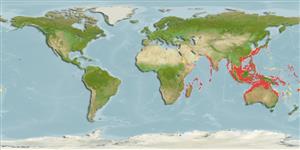Common names from other countries
Classification / Names / Names
Nomi Comuni | Sinonimi | Catalog of Fishes (gen., sp.) | ITIS | CoL | WoRMS
Environment: milieu / climate zone / depth range / distribution range
Ecologia
; distribuzione batimetrica 0 - 330 m (Ref. 81020). Tropical
Indo-West Pacific.
Length at first maturity / Size / Peso / Age
Maturity: Lm ? range ? - ? cm Max length : 15.0 cm TL maschio/sesso non determinato; (Ref. 118)
Reported from India, Thailand, Indonesia, Philippines and Australia. Lives in slightly less saline waters (Ref. 118).
Life cycle and mating behavior
Maturità | Riproduzione | Deposizione | Uova | Fecundity | Larve
Members of the class Holothuroidea are gonochoric and have only one gonad. Spawning and fertilization are both external and some exhibit brooding. Life cycle: Embryos develop into planktotrophic larvae (auricularia) then into doliolaria (barrel-shaped stage) which later metamorphose into juvenile sea cucumbers.
UNEP-WCMC. 2003. (Ref. 97)
IUCN Red List Status (Ref. 130435)
CITES status (Ref. 108899)
Not Evaluated
Not Evaluated
Threat to humans
Harmless
Human uses
| FishSource |
Strumenti
Informazioni ulteriori
Age/Size
Accrescimento
Length-weight
Length-length
Morfologia
Larve
Abbondanza
Fonti Internet
Estimates based on models
Preferred temperature
(Ref.
115969): 16.4 - 28.2, mean 25.9 (based on 1132 cells).
Vulnerability
Low vulnerability (10 of 100).
Price category
Unknown.
